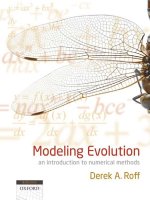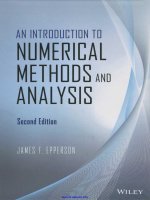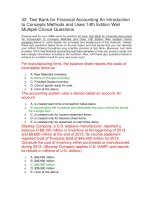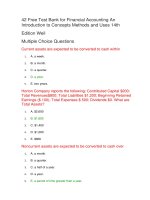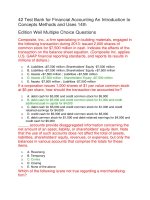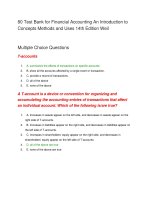An introduction to numerical methods and analysis, 2nd edition
Bạn đang xem bản rút gọn của tài liệu. Xem và tải ngay bản đầy đủ của tài liệu tại đây (22.12 MB, 615 trang )
www.it-ebooks.info
www.it-ebooks.info
AN INTRODUCTION TO
NUMERICAL METHODS
AND ANALYSIS
www.it-ebooks.info
www.it-ebooks.info
AN INTRODUCTION TO
NUMERICAL METHODS
AND ANALYSIS
Second Edition
JAMES F. EPPERSON
Mathematical Reviews
WILEY
www.it-ebooks.info
Copyright © 2013 by John Wiley & Sons, Inc. All rights reserved.
Published by John Wiley & Sons, Inc., Hoboken, New Jersey.
Published simultaneously in Canada.
No part of this publication may be reproduced, stored in a retrieval system or transmitted in any form or by any means,
electronic, mechanical, photocopying, recording, scanning or otherwise, except as permitted under Section 107 or 108
of the 1976 United States Copyright Act, without either the prior written permission of the Publisher, or authorization
through payment of the appropriate per-copy fee to the Copyright Clearance Center, Inc., 222 Rosewood Drive,
Danvers, MA 01923, (978) 750-8400, fax (978) 750-4470, or on the web at www.copyright.com. Requests to the
Publisher for permission should be addressed to the Permissions Department, John Wiley & Sons, Inc., 111 River
Street, Hoboken, NJ 07030, (201) 748-6011, fax (201) 748-6008, or online at />Limit of Liability/Disclaimer of Warranty: While the publisher and author have used their best efforts in preparing this
book, they make no representation or warranties with respect to the accuracy or completeness of the contents of this
book and specifically disclaim any implied warranties of merchantability or fitness for a particular purpose. No
warranty may be created or extended by sales representatives or written sales materials. The advice and strategies
contained herein may not be suitable for your situation. You should consult with a professional where appropriate.
Neither the publisher nor author shall be liable for any loss of profit or any other commercial damages, including but
not limited to special, incidental, consequential, or other damages.
For general information on our other products and services please contact our Customer Care Department within the
United States at (800) 762-2974, outside the United States at (317) 572-3993 or fax (317) 572-4002.
Wiley also publishes its books in a variety of electronic formats. Some content that appears in print, however, may not
be available in electronic formats. For more information about Wiley products, visit our web site at www.wiley.com.
Library of Congress Cataloging-in-Publication Data:
Epperson, James F., author.
An introduction to numerical methods and analysis / James F. Epperson, Mathematical Reviews. — Second edition.
pages cm
Includes bibliographical references and index.
ISBN 978-1-118-36759-9 (hardback)
1. Numerical analysis. I. Title.
QA297.E568 2013
518—dc23
2013013979
Printed in the United States of America.
10 9 8 7 6 5 4 3 2 1
www.it-ebooks.info
To Mom (1920-1986) and Ed (1917-2012)
a story of love, faith, and grace
www.it-ebooks.info
www.it-ebooks.info
CONTENTS
Preface
1
Introductory Concepts and Calculus Review
1.1
1.2
1.3
1.4
1.5
1.6
1.7
1.8
2
xiii
Basic Tools of Calculus
1.1.1
Taylor's Theorem
1.1.2
Mean Value and Extreme Value Theorems
Error, Approximate Equality, and Asymptotic Order Notation
1.2.1
Error
1.2.2
Notation: Approximate Equality
1.2.3
Notation: Asymptotic Order
A Primer on Computer Arithmetic
A Word on Computer Languages and Software
Simple Approximations
Application: Approximating the Natural Logarithm
A Brief History of Computing
Literature Review
References
1
2
2
9
14
14
15
16
20
29
30
35
37
40
41
A Survey of Simple Methods and Tools
43
2.1
2.2
43
48
Homer's Rule and Nested Multiplication
Difference Approximations to the Derivative
vii
www.it-ebooks.info
CONTENTS
2.3
2.4
2.5
2.6
2.7
Application: Euler's Method for Initial Value Problems
Linear Interpolation
Application—The Trapezoid Rule
Solution of Tridiagonal Linear Systems
Application: Simple Two-Point Boundary Value Problems
Root-Finding
3.1
3.2
3.3
3.4
3.5
3.6
3.7
3.8
3.9
3.10
3.11
3.12
3.13
56
62
68
78
85
89
The Bisection Method
Newton's Method: Derivation and Examples
How to Stop Newton's Method
Application: Division Using Newton's Method
The Newton Error Formula
Newton's Method: Theory and Convergence
Application: Computation of the Square Root
The Secant Method: Derivation and Examples
Fixed-Point Iteration
Roots of Polynomials, Part 1
Special Topics in Root-finding Methods
3.11.1 Extrapolation and Acceleration
3.11.2 Variants of Newton's Method
3.11.3 The Secant Method: Theory and Convergence
3.11.4 Multiple Roots
3.11.5 In Search of Fast Global Convergence: Hybrid Algorithms
Very High-order Methods and the Efficiency Index
Literature and Software Discussion
References
90
97
103
106
110
115
119
122
126
136
143
143
147
151
155
159
165
168
168
Interpolation and Approximation
171
4.1
4.2
4.3
4.4
4.5
4.6
4.7
4.8
171
177
187
192
195
198
202
210
210
211
223
228
234
4.9
4.10
4.11
Lagrange Interpolation
Newton Interpolation and Divided Differences
Interpolation Error
Application: Muller's Method and Inverse Quadratic Interpolation
Application: More Approximations to the Derivative
Hermite Interpolation
Piecewise Polynomial Interpolation
An Introduction to Splines
4.8.1
Definition of the Problem
4.8.2
Cubic B-Splines
Application: Solution of Boundary Value Problems
Tension Splines
Least Squares Concepts in Approximation
www.it-ebooks.info
CONTENTS
4.12
4.13
4.11.1 An Introduction to Data Fitting
4.11.2 Least Squares Approximation and Orthogonal Polynomials
Advanced Topics in Interpolation Error
4.12.1 Stability of Polynomial Interpolation
4.12.2 The Runge Example
4.12.3 The Chebyshev Nodes
Literature and Software Discussion
References
iX
234
237
250
250
253
255
261
262
Numerical Integration
263
5.1
5.2
5.3
5.4
5.5
5.6
5.7
5.8
A Review of the Definite Integral
Improving the Trapezoid Rule
Simpson's Rule and Degree of Precision
The Midpoint Rule
Application: Stirling's Formula
Gaussian Quadrature
Extrapolation Methods
Special Topics in Numerical Integration
5.8.1
Romberg Integration
5.8.2
Quadrature with Non-smooth Integrands
5.8.3
Adaptive Integration
5.8.4
Peano Estimates for the Trapezoid Rule
Literature and Software Discussion
References
264
266
271
282
286
288
300
307
307
312
317
322
328
328
Numerical Methods for Ordinary Differential Equations
329
6.1
6.2
6.3
6.4
330
335
339
342
344
347
352
354
359
366
366
370
372
372
376
5.9
6.5
6.6
6.7
The Initial Value Problem: Background
Euler's Method
Analysis of Euler's Method
Variants of Euler's Method
6.4.1
The Residual and Truncation Error
6.4.2
Implicit Methods and Predictor-Corrector Schemes
6.4.3
Starting Values and Multistep Methods
6.4.4
The Midpoint Method and Weak Stability
Single-Step Methods: Runge-Kutta
Multistep Methods
6.6.1
The Adams Families
6.6.2
The BDF Family
Stability Issues
6.7.1
Stability Theory for Multistep Methods
6.7.2
Stability Regions
www.it-ebooks.info
X
CONTENTS
6.8
6.9
6.10
6.11
Application to Systems of Equations
6.8.1
Implementation Issues and Examples
6.8.2
Stiff Equations
6.8.3
A-Stability
Adaptive Solvers
Boundary Value Problems
6.10.1 Simple Difference Methods
6.10.2 Shooting Methods
6.10.3 Finite Element Methods for BVPs
Literature and Software Discussion
References
378
378
381
382
386
399
399
403
407
414
415
Numerical Methods for the Solution of Systems of Equations
417
7.1
7.2
7.3
7.4
7.5
418
420
427
430
441
441
443
450
453
457
460
469
469
472
7.6
7.7
7.8
7.9
7.10
Linear Algebra Review
Linear Systems and Gaussian Elimination
Operation Counts
The LU Factorization
Perturbation, Conditioning, and Stability
7.5.1
Vector and Matrix Norms
7.5.2
The Condition Number and Perturbations
7.5.3
Estimating the Condition Number
7.5.4
Iterative Refinement
SPD Matrices and the Cholesky Decomposition
Iterative Methods for Linear Systems: A Brief Survey
Nonlinear Systems: Newton's Method and Related Ideas
7.8.1
Newton's Method
7.8.2
Fixed-Point Methods
Application: Numerical Solution of Nonlinear Boundary Value
Problems
Literature and Software Discussion
References
474
477
477
Approximate Solution of the Algebraic Eigenvalue Problem
479
8.1
8.2
8.3
8.4
8.5
8.6
479
485
490
509
518
519
519
Eigenvalue Review
Reduction to Hessenberg Form
Power Methods
An Overview of the QR Iteration
Application: Roots of Polynomials, Part II
Literature and Software Discussion
References
www.it-ebooks.info
CONTENTS
9
A Survey of Numerical Methods for Partial Differential
Equations
9.1
9.2
9.3
9.4
10
Difference Methods for the Diffusion Equation
9.1.1
The Basic Problem
9.1.2
The Explicit Method and Stability
9.1.3
Implicit Methods and the Crank-Nicolson Method
Finite Element Methods for the Diffusion Equation
Difference Methods for Poisson Equations
9.3.1
Discretization
9.3.2
Banded Cholesky Solvers
9.3.3
Iteration and the Method of Conjugate Gradients
Literature and Software Discussion
References
Xi
521
521
521
522
527
536
539
539
542
543
553
553
An Introduction to Spectral Methods
555
10.1
10.2
10.3
10.4
556
568
577
579
579
Spectral Methods for Two-Point Boundary Value Problems
Spectral Methods for Time-Dependent Problems
Clenshaw-Curtis Quadrature
Literature and Software Discussion
References
Appendix A: Proofs of Selected Theorems,
and Additional Material
A. 1
A.2
A.3
A.4
Proofs of the Interpolation Error Theorems
Proof of the Stability Result for ODEs
Stiff Systems of Differential Equations and Eigenvalues
The Matrix Perturbation Theorem
Index
www.it-ebooks.info
581
581
583
584
586
www.it-ebooks.info
PREFACE
Preface to the Second Edition
This third version of the text is officially the Second Edition, because the second version
was officially dubbed the Revised Edition. Now that the confusing explanation is out of
the way, we can ask the important question: What is new?
• I continue to chase down typographical errors, a process that reminds me of herding
cats. I'd like to thank everyone who has sent me information on this, especially
Prof. Mark Mills of Central College in Pella, Iowa. I have become resigned to the
notion that a typo-free book is the result of a (slowly converging) limiting process,
and therefore is unlikely to be actually achieved. But I do keep trying.
• The text now assumes that the student is using MATLAB for computations, and
many MATLAB routines are discussed and used in examples. I want to emphasize
that this book is still a mathematics text, not a primer on how to use MATLAB.
• Several biographies were updated as more complete information has become widely
available on the Internet, and a few have been added.
• Two sections, one on adaptive quadrature (§5.8.3) and one on adaptive methods for
ODEs (§6.9) have been re-written to reflect the decision to rely more on MATLAB.
• Chapter 9 (A Survey of Numerical Methods for Partial Differential Equations) has
been extensively re-written, with more examples and graphics.
XIII
www.it-ebooks.info
XIV
PREFACE
• New material has been added:
- Two sections on roots of polynomials. The first (§3.10) introduces the DurandKerner algorithm; the second (§8.5) discusses using the companion matrix to
find polynomial roots as matrix eigenvalues.
- A section (§3.12) on very high-order root-finding methods.
- A section (§4.10) on splines under tension, also known as "taut splines;"
- Sections on the finite element method for ODEs (§6.10.3) and some PDEs
(§9.2);
- An entire chapter (Chapter 10) on spectral methods1.
• Several sections have been modified somewhat to reflect advances in computing
technology.
• Later in this preface I devote some time to outlining possible chapter and section
selections for different kinds of courses using this text.
It might be appropriate for me to describe how I see the material in the book. Basically,
I think it breaks down into three categories:
• The fundamentals: All of Chapters 1 and 2, most of Chapters 3 (3.1, 3.2, 3.3, 3.5,
3.8, 3.9), 4 (4.1, 4.2, 4.3, 4.6, 4.7, 4.8, 4.11), and 5 (5.1, 5.2, 5.3, 5.4, 5.7); this is
the basic material in numerical methods and analysis and should be accessible to any
well-prepared students who have completed a standard calculus sequence.
• Second level: Most of Chapters 6, 7, and 8, plus much of the remaining sections
from Chapters 3 (3.4, 3.6, 3.7, 3.10), 4 (4.4, 4.5), and 5 (5.5, 5.6), and some of 6
(6.8) and 7 (7.7); this is the more advanced material and much of it (from Chap. 6)
requires a course in ordinary differential equations or (Chaps. 7 and 8) a course in
linear algebra. It is still part of the core of numerical methods and analysis, but it
requires more background.
• Advanced: Chapters 9 and 10, plus the few remaining sections from Chapters 3, 4,
5, 6, 7, and 8.
• It should go without saying that precisely what is considered "second level" or
"advanced" is largely a matter of taste.
As always, I would like to thank my employer, Mathematical Reviews, and especially
the Executive Editor, Graeme Fairweather, for the study leave that gave me the time to
prepare (for the most part) this new edition; my editor at John Wiley & Sons, Susanne
Steitz-Filler, who does a good job of putting up with me; an anonymous copy-editor at
Wiley who saved me from a large number of self-inflicted wounds; and—most of all—my
family of spouse Georgia, daughter Elinor, son James, and Border Collie mutts Samantha
'The material on spectral methods may well not meet with the approval of experts on the subject, as I presented
the material in what appears to be a very non-standard way, and I left out a lot of important issues that make
spectral methods, especially for time dependent problems, practical. I did it this way because I wanted to write an
introduction to the material that would be accessible to students taking a first course in numerical analysis/methods,
and also in order to avoid cluttering up the exposition with what I considered to be "side issues." I appreciate
that these side issues have to be properly treated to make spectral methods practical, but since this tries to be an
elementary text, I wanted to keep the exposition as clean as possible.
www.it-ebooks.info
PREFACE
XV
and Dylan. James was not yet born when I first began writing this text in 1997, and now
he has finished his freshman year of high school; Elinor was in first grade at the beginning
and graduated from college during the final editing process for this edition. I'm very proud
of them both! And I can never repay the many debts that I owe to my dear spouse.
Online Material
There will almost surely be some online material to supplement this text. At a minimum,
there will be
• MATLAB files for computing and/or reading Gaussian quadrature (§5.6) weights
and abscissas for N = 2 m , m = 0 , 1 , 2 , . . . , 10.
• Similar material for computing and/or reading Clenshaw-Curtis (§10.3) weights and
abscissas.
• Color versions of some plots from Chapter 9.
• It is possible that there will be an entire additional section for Chapter 3.
To access the online material, go to
www.wiley.com/go/epperson2edition
The webpage should be self-explanatory.
A Note About the Dedication
The previous editions were dedicated to six teachers who had a major influence on the
author's mathematics education: Frank Crosby and Ed Croteau of New London High
School, New London, CT; Prof. Fred Gehring and Prof. Peter Duren of the University of
Michigan Department of Mathematics; and Prof. Richard MacCamy and Prof. George J.
Fix of the Department of Mathematics, Carnegie-Mellon University, Pittsburgh, PA. (Prof.
Fix served as the author's doctoral advisor.) I still feel an unpayable debt of gratitude to
these men, who were outstanding teachers, but I felt it appropriate to express my feelings
about my parents for this edition, hence the new dedication to the memory of my mother
and step-father.
Course Outlines
One can define several courses from this book, based on the level of preparation of the
students and the number of terms the course runs, as well as the level of theoretical detail
the instructor wishes to address. Here are some example outlines that might be used.
• A single semester course that does not assume any background in linear algebra or
differential equations, and which does not emphasize theoretical analysis of methods:
www.it-ebooks.info
XVI
PREFACE
-
Chapter 1 (all sections2);
Chapter 2 (all sections3);
Chapter 3 (Sections 3.1-3.3,3.8-3.10);
Chapter 4 (Sections 4.1-4.8);
Chapter 5 (Sections 5.1-5.7).
• A two-semester course which assumes linear algebra and differential equations for
the second semester:
-
Chapter 1 (all sections);
Chapter 2 (all sections);
Chapter 3 (Sections 3.1-3.3,3.8-3.10);
Chapter 4 (Sections 4.1^.8);
Chapter 5 (Sections 5.1-5.7).
Semester break should probably come here.
Chapter 6 (6.1-6.6; 6.10 if time/preparation permits)
Chapter 7 (7.1-7.6)
Chapter 8 (8.1-8.4)
Additional material at the instructor's discretion.
• A two-semester course for well-prepared students:
-
Chapter 1 (all sections);
Chapter 2 (all sections);
Chapter 3 (Sections 3.1-3.10; 3.11 at the discretion of the instructor);
Chapter 4 (Sections 4.1-4.11, 4.12.1, 4.12.3; 4.12.2 at the discretion of the
instructor);
Chapter 5 (Sections 5.1-5.7, 5.8.1; other sections at the discretion of the instructor).
Semester break should probably come here.
Chapter 6 (6.1-6.8; 6.10 if time/preparation permits; other sections at the
discretion of the instructor)
Chapter 7 (7.1-7.8; other sections at the discretion of the instructor)
Chapter 8 (8.1-8.4)
Additional material at the instructor's taste and discretion.
Some sections appear to be left out of all these outlines. Most textbooks are written to
include extra material, to facilitate those instructors who would like to expose their students
to different material, or as background for independent projects, etc.
I want to encourage anyone—teachers, students, random readers—to contact me with
questions, comments, suggestions, or remaining typos. My professional email is still
jfeQams.org
2
§§1.5and 1.6 are included in order to expose students to the issue of approximation; if an instructor feels that
the students in his or her class do not need this exposure, these sections can be skipped in favor of other material
from later chapters.
3
The material on ODEs and tridiagonal systems can be taught to students who have not had a normal ODE or
linear algebra course.
www.it-ebooks.info
PREFACE
XVM
Computer Access
Because the author no longer has a traditional academic position, his access to modern
software is limited. Most of the examples were done using a very old and limited version
of MATLAB from 1994. (Some were done on a Sun workstation, using FORTRAN code,
in the late 1990s.) The more involved and newer examples were done using public access
computers at the University of Michigan's Duderstadt Center, and the author would like to
express his appreciation to this great institution for this.
A Note to the Student
(This is slightly updated from the version in the First Edition.) This book was written to
be read. I am under no illusions that this book will compete with the latest popular novel
for interest or thrilling narrative. But I have tried very hard to write a book on mathematics
that can be read by students. So do not simply buy the book, work the exercises, and sell
the book back to the bookstore at the end of the term. Read the text, think about what you
have read, and ask your instructor questions about the things that you do not understand.
Numerical methods and analysis is a very different area of mathematics, certainly different from what you have seen in your previous courses. It is not harder, but the differentness
of the material makes it seem harder. We worry about different issues than those in other
mathematics classes. In a calculus course you are typically asked to compute the derivative
or antiderivative of a given function, or to solve some equation for a particular unknown.
The task is clearly defined, with a very concrete notion of "the right answer." Here, we
are concerned with computing approximations, and this involves a slightly different kind
of thinking. We have to understand what we are approximating well enough to construct
a reasonable approximation, and we have to be able to think clearly and logically enough
to analyze the accuracy and performance of that approximation. One former student has
characterized this course material as "rigorously imprecise" or "approximately precise."
Both are appropriate descriptions. Rote memorization of procedures is not of use here; it is
vital in this course that the student learn the underlying concepts. Numerical mathematics
is also experimental in nature. A lot can be learned simply by trying something out and
seeing how the computation goes.
Preface to the Revised Edition
First, I would like to thank John Wiley for letting me do a Revised Edition of An Introduction
to Numerical Methods and Analysis, and in particular I would like to thank Susanne Steitz
and Laurie Rosatone for making it all possible.
So, what's new about this edition? A number of things. For various reasons, a large
number of typographical and similar errors managed to creep into the original edition. These
have been aggressively weeded out and fixed in this version. I'd like to thank everyone
who emailed me with news of this or that error. In particular, I'd like to acknowledge
Marzia Rivi, who translated the first edition into Italian and who emailed me with many
typos, Prof. Nicholas Higham of Manchester University, Great Britain, and Mark Mills of
Central College in Pella, Iowa. I'm sure there's a place or two where I did something silly
like reversing the order of subtraction. If anyone finds any error of any sort, please email
me at j f eOams. org.
www.it-ebooks.info
XVÜi
PREFACE
I considered adding sections on a couple of new topics, but in the end decided to leave
the bulk of the text alone. I spent some time improving the exposition and presentation,
but most of the text is the same as the first edition, except for fixing the typos.
I would be remiss if I did not acknowledge the support of my employer, the American
Mathematical Society, who granted me a study leave so I could finish this project. Executive
Director John Ewing and the Executive Editor of Mathematical Reviews, Kevin Clancey,
deserve special mention in this regard. Amy Hendrikson of TeXnology helped with some
I4TEX issues, as did my colleague at Mathematical Reviews, Patrick Ion. Another colleague,
Maryse Brouwers, an extraordinary grammarian, helped greatly with the final copyediting
process.
The original preface has the URL for the text website wrong; just go to www. wiley. com
and use their links to find the book. The original preface also has my old professional
email. The updated email is j feOams. org; anyone with comments on the text is welcome
to contact me.
But, as is always the case, it is the author's immediate family who deserve the most
credit for support during the writing of a book. So, here goes a big thank you to my wife,
Georgia, and my children, Elinor and Jay. Look at it this way, kids: The end result will pay
for a few birthdays.
Preface (To the First Edition)
This book is intended for introductory and advanced courses in numerical methods and
numerical analysis, for students majoring in mathematics, sciences, and engineering. The
book is appropriate for both single-term survey courses or year-long sequences, where
students have a basic understanding of at least single-variable calculus and a programming
language. (The usual first courses in linear algebra and differential equations are required
for the last four chapters.)
To provide maximum teaching flexibility, each chapter and each section begins with the
basic, elementary material and gradually builds up to the more advanced material. This
same approach is followed with the underlying theory of the methods. Accordingly, one
can use the text for a "methods" course that eschews mathematical analysis, simply by not
covering the sections that focus on the theoretical material. Or, one can use the text for a
survey course by only covering the basic sections, or the extra topics can be covered if you
have the luxury of a full year course.
The objective of the text is for students to learn where approximation methods come
from, why they work, why they sometimes don't work, and when to use which of many
techniques that are available, and to do all this in a style that emphasizes readability and
usefulness to the beginning student. While these goals are shared by other texts, it is the
development and delivery of the ideas in this text that I think makes it different.
A course in numerical computation—whether it emphasizes the theory or the methods—
requires that students think quite differently than in other mathematics courses, yet students
are often not experienced in the kind of problem-solving skills and mathematical judgment
that a numerical course requires. Many students react to mathematics problems by pigeonholing them by category, with little thought given to the meaning of the answer. Numerical
mathematics demands much more judgment and evaluation in light of the underlying theory,
and in the first several weeks of the course it is crucial for students to adapt their way of
thinking about and working with these ideas, in order to succeed in the course.
www.it-ebooks.info
PREFACE
XIX
To enable students to attain the appropriate level of mathematical sophistication, this
text begins with a review of the important calculus results, and why and where these
ideas play an important role in this course. Some of the concepts required for the study
of computational mathematics are introduced, and simple approximations using Taylor's
theorem are treated in some depth, in order to acquaint students with one of the most
common and basic tools in the science of approximation. Computer arithmetic is treated in
perhaps more detail than some might think necessary, but it is instructive for many students
to see the actual basis for rounding error demonstrated in detail, at least once.
One important element of this text that I have not seen in other texts is the emphasis
that is placed on "cause and effect" in numerical mathematics. For example, if we apply
the trapezoid rule to (approximately) integrate a function, then the error should go down
by a factor of 4 as the mesh decreases by a factor of 2; if this is not what happens, then
almost surely there is either an error in the code or the integrand is not sufficiently smooth.
While this is obvious to experienced practitioners in the field, it is not obvious to beginning
students who are not confident of their mathematical abilities. Many of the exercises and
examples are designed to explore this kind of issue.
Two common starting points to the course are root-finding or linear systems, but diving
in to the treatment of these ideas often leaves the students confused and wondering what the
point of the course is. Instead, this text provides a second chapter designed as a "toolbox" of
elementary ideas from across several problem areas; it is one of the important innovations
of the text. The goal of the toolbox is to acclimate the students to the culture of numerical
methods and analysis, and to show them a variety of simple ideas before proceeding to
cover any single topic in depth. It develops some elementary approximations and methods
that the students can easily appreciate and understand, and introduces the students, in the
context of very simple methods and problems, to the essence of the analytical and coding
issues that dominate the course. At the same time, the early development of these tools
allows them to be used later in the text in order to derive and explain some algorithms in
more detail than is usually the case.
The style of exposition is intended to be more lively and "student friendly" than the
average mathematics text. This does not mean that there are no theorems stated and proved
correctly, but it does mean that the text is not slavish about it. There is a reason for this: The
book is meant to be read by the students. The instructor can render more formal anything in
the text that he or she wishes, but if the students do not read the text because they are turned
off by an overly dry regimen of definition, theorem, proof, corollary, then all of our effort
is for naught. In places, the exposition may seem a bit wordier than necessary, and there
is a significant amount of repetition. Both are deliberate. While brevity is indeed better
mathematical style, it is not necessarily better pedagogy. Mathematical textbook exposition
often suffers from an excess of brevity, with the result that the students cannot follow the
arguments as presented in the text. Similarly, repetition aids learning, by reinforcement.
Nonetheless I have tried to make the text mathematically complete. Those who wish
to teach a lower-level survey course can skip proofs of many of the more technical results
in order to concentrate on the approximations themselves. An effort has been made—not
always successfully—to avoid making basic material in one section depend on advanced
material from an earlier section.
The topics selected for inclusion are fairly standard, but not encyclopedic. Emerging
areas of numerical analysis, such as wavelets, are not (in the author's opinion) appropriate
for a first course in the subject. The same reasoning dictated the exclusion of other,
more mature areas, such as the finite element method, although that might change in
future editions should there be sufficient demand for it. A more detailed treatment of
www.it-ebooks.info
XX
PREFACE
approximation theory, one of the author's favorite topics, was also felt to be poorly suited
to a beginning text. It was felt that a better text would be had by doing a good job covering
some of the basic ideas, rather than trying to cover everything in the subject.
The text is not specific to any one computing language. Most illustrations of code are
made in an informal pseudo-code, while more involved algorithms are shown in a "macrooutline" form, and programming hints and suggestions are scattered throughout the text.
The exercises assume that the students have easy access to and working knowledge of
software for producing basic Cartesian graphs.
A diskette of programs is not provided with the text, a practice that sets this book at odds
with many others, but which reflects the author's opinion that students must learn how to
write and debug programs that implement the algorithms in order to learn the underlying
mathematics. However, since some faculty and some departments structure their courses
differently, a collection of program segments in a variety of languages is available on the
text web site so that instructors can easily download and then distribute the code to their
students. Instructors and students should be aware that these are program segments; none
of them are intended to be ready-to-run complete programs. Other features of the text web
site are discussed below. (Note: This material may be removed from the Revised Edition
website.)
Exercises run the gamut from simple hand computations that might be characterized as
"starter exercises" to challenging derivations and minor proofs to programming exercises
designed to test whether or not the students have assimilated the important ideas of each
chapter and section. Some of the exercises are taken from application situations, some are
more traditionally focused on the mathematical issues for their own sake. Each chapter
concludes with a brief section discussing existing software and other references for the
topic at hand, and a discussion of material not covered in this text.
Historical notes are scattered throughout the text, with most named mathematicians
being accorded at least a paragraph or two of biography when they are first mentioned.
This not only indulges my interest in the history of mathematics, but it also serves to engage
the interest of the students.
The web site for the text ( will contain, in addition to the
set of code segments mentioned above, a collection of additional exercises for the text, some
application modules demonstrating some more involved and more realistic applications of
some of the material in the text, and, of course, information about any updates that are going
to be made in future editions. Colleagues who wish to submit exercises or make comments
about the text are invited to do so by contacting the author at eppersonSmath. uah. edu.
Notation
Most notation is defined as it appears in the text, but here we include some commonplace
items.
K — The real number line; R = (-co, oo).
M.n — The vector space of real vectors of n components.
Rnx™ — The vector space of real nx n matrices.
C([a, b]) — The set of functions / which are defined on the interval [a, b], continuous on
all of (a, b), and continuous from the interior of [a, b] at the endpoints.
www.it-ebooks.info
PREFACE
ΧΧί
Ck ( [a, b] ) — The set of functions / such that / and its first k derivatives are all in C( [o, b] ).
Cp,g (Q) — The set of all functions u that are defined on the two-dimensional domain Q =
{(x, t) | a < x < b, 0 < t < T}, and that are p times continuously differentiable in
x for all t, and q times continuously differentiable in t for all x.
« — Approximately equal. When we say that A « B, we mean that A and B are
approximations to each other. See §1.2.2.
= — Equivalent. When we say that f(x) — g{x), we mean that the two functions agree
at the single point x. When we say that f(x) = g{x), we mean that they agree at all
points x. The same thing is said by using just the function names, i.e., f = g.
O — On the order of ("big O of"). We say that A = B + 0(D(h)) whenever
CD(h) for some constant C and for all h sufficiently small. See §1.2.3.
\A-B\<
u — Machine epsilon. The largest number such that, in computer arithmetic, 1 + u = 1.
Architecture dependent, of course. See §1.3.
sgn — Sign function. The value of sgn(x) is 1, —1, or 0, depending on whether or not x
is positive, negative, or zero, respectively.
www.it-ebooks.info
www.it-ebooks.info
CHAPTER 1
INTRODUCTORY CONCEPTS AND
CALCULUS REVIEW
It is best to start this book with a question: What do we mean by "Numerical Methods and
Analysis"? What kind of mathematics is this book about?
Generally and broadly speaking, this book covers the mathematics and methodologies
that underlie the techniques of scientific computation. More prosaically, consider the button
on your calculator that computes the sine of the number in the display. Exactly how does
the calculator know that correct value? When we speak of using the computer to solve
a complicated mathematics or engineering problem, exactly what is involved in making
that happen? Are computers "born" with the knowledge of how to solve complicated
mathematical and engineering problems? No, of course they are not. Mostly they are
programmed to do it, and the programs implement algorithms that are based on the kinds
of things we talk about in this book.
Textbooks and courses in this area generally follow one of two main themes: Those titled
"Numerical Methods" tend to emphasize the implementation of the algorithms, perhaps at
the expense of the underlying mathematical theory that explains why the methods work;
those titled "Numerical Analysis" tend to emphasize this underlying mathematical theory,
perhaps at the expense of some of the implementation issues. The best approach, of course,
is to properly mix the study of the algorithms and their implementation ("methods") with
the study of the mathematical theory ("analysis") that supports them. This is our goal in
this book.
Whenever someone speaks of using a computer to design an airplane, predict the weather,
or otherwise solve a complex science or engineering problem, that person is talking about
using numerical methods and analysis. The problems and areas of endeavor that use these
An Introduction to Numerical Methods and Analysis, Second Edition. By James F. Epperson
Copyright © 2013 John Wiley & Sons, Inc.
www.it-ebooks.info
1
